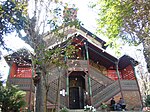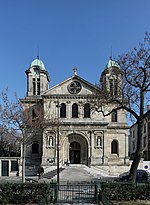Ourcq station
Pages with French IPAParis Métro line 5Paris Métro stations in the 19th arrondissement of ParisParis Métro stubsRailway stations in France opened in 1942

Ourcq (French pronunciation: [uʁk]) is a station in the 19th arrondissement of Paris, served by line 5 of the Paris Métro. It is named after the nearby rue de l'Ourcq, which in turn was named after the river Ourcq, a tributary of the Marne (river). It rises in Aisne and flows into Île-de-France. It is connected to the Seine via the Canal de l'Ourcq.
Excerpt from the Wikipedia article Ourcq station (License: CC BY-SA 3.0, Authors, Images).Ourcq station
Avenue Jean Jaurès, Paris 19th Arrondissement (Paris)
Geographical coordinates (GPS) Address Nearby Places Show on map
Geographical coordinates (GPS)
| Latitude | Longitude |
|---|---|
| N 48.887 ° | E 2.386 ° |
Address
Avenue Jean Jaurès 151
75019 Paris, 19th Arrondissement (Paris)
Ile-de-France, France
Open on Google Maps










